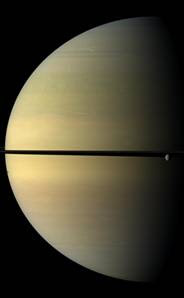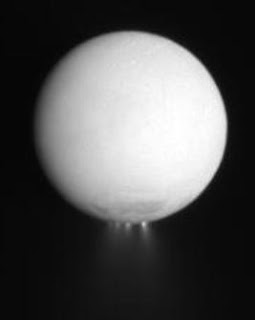 The Cassini orbiter has been working overtime during the holidays to deliver a cartload of gifts from Saturn and its moons. Highlights include fresh views of frost-spewing Enceladus and yam-shaped Prometheus, plus a "Nutcracker"-style ballet of Saturnian satellites.
The Cassini orbiter has been working overtime during the holidays to deliver a cartload of gifts from Saturn and its moons. Highlights include fresh views of frost-spewing Enceladus and yam-shaped Prometheus, plus a "Nutcracker"-style ballet of Saturnian satellites. The excitement began last week with the animated images of moonsimage advisory, the folks who process Cassini's pictures compared the interplay to the dance of the Sugar Plum Fairy from Tchaikovsky's "Nutcracker" ballet. passing back and forth with the giant planet and its rings as a backdrop. In an
My favorite movie is "Moon Jumble," which has Rhea in the starring role, joined by its siblings Janus, Mimas and Pandora. (That's the real Pandora, not the fictional "Avatar" moon). Make sure you stretch your browser window wide enough to take in the whole picture.
"As yet another year in Saturn orbit draws to a close, these wondrous movies of an alien place clear across the solar system remind us how fortunate we are to be engaged in this magnificent exploratory expedition," imaging team leader Carolyn Porco said. "So, from all of us on the Cassini Imaging Team to all of you, Happy Holidays!"
That might fool you into thinking the Cassini team was taking the holidays off. There's no way that was going to happen. On Christmas and the day after, the orbiter snapped pictures as it flew past Enceladus and Prometheus. Over the weekend, Cassini zoomed within 600 miles (960 kilometers) of Titan's north pole.
A sampling of the raw imagery released on Sunday includes a striking full-disk view of Enceladus and its geysers of water ice, spewing out from southern fissures that have been nicknamed "tiger stripes." Such geysers hint at the existence of a subsurface ocean beneath Enceladus' icy surface - an ocean that just might harbor alien life.
The latest picture was taken from a distance of 383,000 miles (617,000 kilometers), and it might make you wonder why those geysers hadn't been spotted decades ago when the Voyager spacecraft flew past. In a posting to the imaging team's Web site, Porco says it wouldn't have been that easy for Voyager to spot the frosty spray.
"We never got a good look at the southern hemisphere with Voyager; we even missed the tiger stripes back then," she wrote. Porco also said "some of the jets - and maybe all of them - are 'intermittent' in the sense that we expect they could turn on and off on a daily timescale (where 'daily' here means 1.3 Earth days)."
Another raw image provides the best view yet of Prometheus, a "shepherding" moon that along with Pandora helps keep Saturn's F ring in line. This view was captured from a distance of 36,000 miles (59,000 kilometers). A farther-out image from Cassini, released five years ago, shows Prometheus at work.
The Planetary Society's Emily Lakdawalla put together the raw imagery to produce a natural-color composite photo of the moon, which measures 74 miles long and as little as 38 miles wide (119 by 87 by 61 kilometers).
"This is one of the more elongated moons to be seen in the solar system, almost exactly twice as long as it is wide," Lakdawalla observes. "The word 'potato' is commonly used to describe the shape of small bodies in the solar system, but I think that Prometheus, with its pointy ends, looks more like a related vegetable, a yam."
The fact that candied yams are a traditional holiday dish makes Prometheus even more palatable as a year-end picture - and whets the appetite for more from Cassini in the year to come.
View this site car shipping car transport auto transport auto shipping






رقم المجاري بالاحساء
ReplyDeleteرقم سيارة المجاري بالاحساء
سيارات شفط المجاري
شركة شفط بيارات بالاحساء